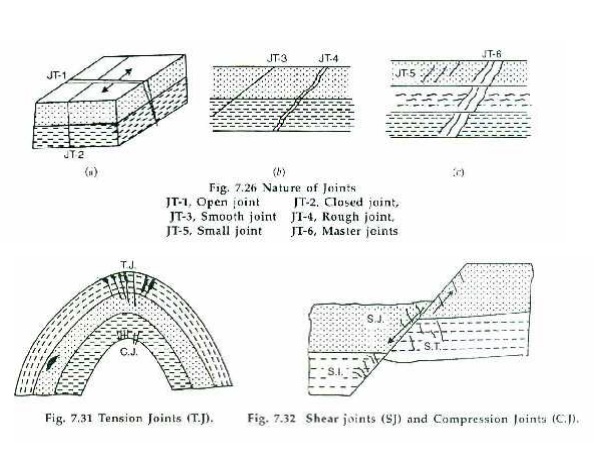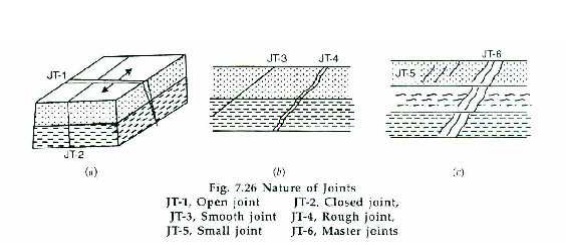Chapter: Civil : Engineering Geology : Structural Geology And Geophysical Method
Structural Geology: Joints And Jointing

JOINTS AND JOINTING
Terminology
Ø Joints
are defined as divisional planes or fractures along which there has been no
relative displacement.
Ø These
fractures divide the rocks into parts or blocks and unlike the faults, the
parts have not suffered any movement along the fracture plane.
Ø There may
be or may not be an opening up of blocks perpendicular to the joint planes.
Ø Nature.
Joints may be open or closed in nature.
Open
joints are those in which the blocks have been separated or opened up for small distances in a direction at right
angles to the fracture surface.
Ø These may
be gradually enlarged by weathering processes and develop into fissure in the
rocks.
Ø In closed
joints, there is no such separation.
Ø Even
then, these joints may be capable of allowing fluids (gases and water) to pass
through the rock
Similarly,
the joints may be smooth or rough on the surface and the surface may be
straight or curved in outline the joints may be small in their extension

Attitude
Ø Joints
are fracture planes or surfaces and their occurrence often takes place in such
a way that their position in space or attitude (dip and strike) may be
described conveniently either independently or with respect to the attitude of
the rocks in which they occur.
CLASSIFICATION
Ø Joints
have been classified on the basis of spatial relationships, geometry and
genesis.
A. Spatial
Relationship
All joints are divided into two
main groups on the basis of presence or otherwise of some regularity in their
occurrence:
1. Systematic
joints (regular joints).
Ø These
show a distinct regularity in their occurrence which can be measured and mapped
easily.
Ø Such
joints occur in parallel or sub-parallel joint sets that are repeated in the
rocks at regular intervals.
Ø The
columnar joints and the mural joints described below are examples of regular or
systematic jointing.
2. Nonsystematic
(or
irregular) joints.
Ø As the
name implies, these joints do not possess any regularity in their occurrence
and distribution.
They
appear at random in the rocks and may have incompletely defined surfaces. In
many cases these are related to the systematic joints in that these occur
between them.
Ø At other
times, the non- systematic joints may show no relationship with the systematic
joints and their curved and rough surfaces may even cut across the former.
B. Geometry
In stratified rocks, joints are generally classified on the
basis of relationship of their attitude with that of the rocks in which they
occur.
Three
types recognized on this basis are :
Strike
joints in which the joint sets strike parallel to the strike of the
rocks.
Dip joints in which the joint sets strike
parallel to the dip direction of the rocks; Oblique joints are those
joints where the strike of the joints is at any angle between the dip
and the strike of the layers. These are also called diagonal joints when they
occur midway between the dip and strike of the layers.
C.
Genesis (Origin)
In such
cases, joints are classified into one of the following genetic types:
Tension joints are those, which have
developed due to the tensile forces acting on the rocks. The most common
location of such joints in folded sequence is on the outer margins of crests
and troughs. They are also produced in igneous rocks during their cooling.
Joints produced in many rocks during the weathering of overlying strata and
subsequent release of stresses by expansion are also thought to be due to the
tensile forces (Fig. 7.31).
Shear joints. These are commonly
observed in the vicinity of fault planes and shear zones where the
relationship with shearing forces is clearly established (Fig. 7.32). In folded
rocks, these are located in axial regions.
Compression
joints. Rocks may be compressed to crushing and numerous joints may
result due to the compressive forces in this case. In the core regions of
folds where compressive forces are dominant, joints may be related to the
compressive forces.

Related Topics